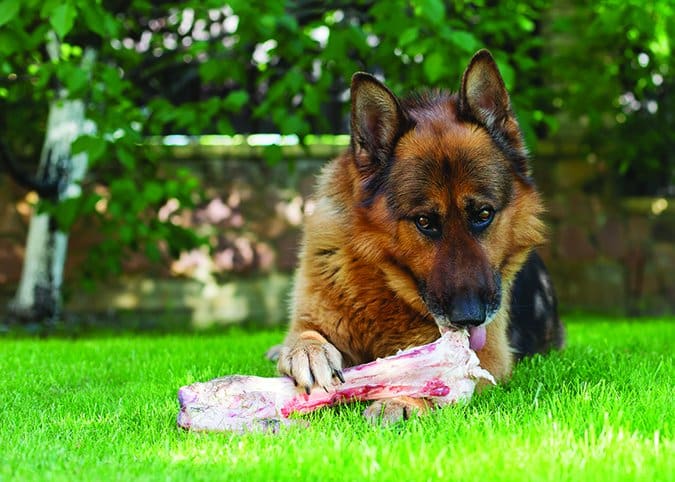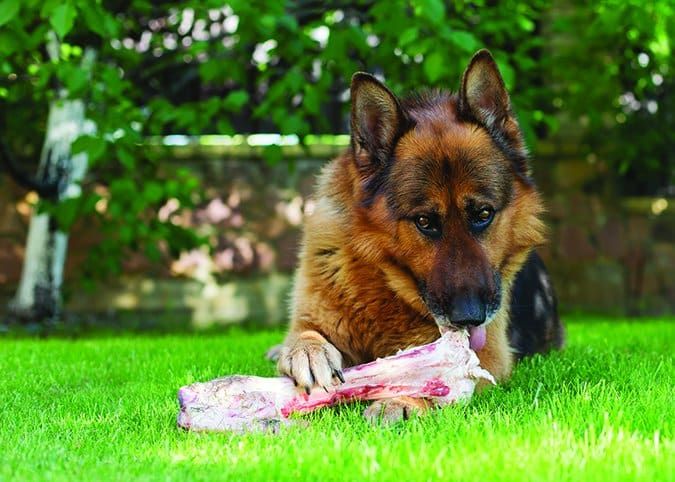The question of how best to feed dogs stimulates great debate and evokes strong emotions among dog folks. (Yes, this an intended understatement.) One of the most contentiously defended viewpoints in recent years is that dogs should not be fed diets that contain digestible carbohydrate (starch).
Two primary arguments are used to defend this position. These are:
A) Dogs are carnivores and have no dietary requirement for carbohydrate.
B) Dogs are unable to efficiently digest starch. Therefore, including starch-providing ingredients in dog foods is unhealthy and provides no nutritional value.
Like many persistent beliefs, there is some truth and some falsehood in both of these blanket claims. Let’s start with the first.
PROPOSED: Dogs are carnivores and have no dietary requirement for carbohydrates.
The first bit is false; the second bit is true. Dogs are classified within the taxonomic order of Carnivora, but like many other species within this order, dogs are omnivorous.

© Tommy Maenhout | Dreamstime.com
The term omnivore simply means that an animal consumes foods that are of animal and plant origin (dogs do this) and can derive essential nutrients from both animal and plant foods (ditto). Based upon this definition, animal nutritionists consider the dog to be an omnivore. By contrast, the domestic cat, along with other felid species, is classified as an obligate carnivore. This classification means that cats cannot derive all of their essential nutrient needs from plant foods and therefore have an obligate need for foods of animal origin in their diet.
The fact that dogs are omnivorous does not signify that they are not predatory (they are), nor that they do not seek out and enjoy eating meat (they do). All that it means is that dogs can consume and derive nutrients from both animal and plant matter.
If we consider the dog’s feeding behavior, it is clear that the majority of dogs enjoy and probably prefer to consume meat in their diet. However, they also scavenge and ingest a wide variety of food types, including starch-containing foods. Nutritionally, just like bears, who also preferably seek out animal source proteins, dogs are omnivores.
Personally, I am baffled as to why “omnivore” has become a fighting word among dog people. This label does not turn the dog into a carrot-munching, Birkenstock-wearing, canine hippie. Rather, it simply describes what the dog eats and is capable of deriving nutrients from: meat and plant matter. That’s all. Time for us all to calm down about this one.
Let’s move on.
So what about carbs? It’s true that dogs have no dietary requirement for carbohydrates; they can derive all the nutrients they need from protein and fat.
That said, cooked starch can provide a highly digestible energy source to dogs when included in their diet. From a nutrition standpoint, dietary carbohydrate spares protein. This means that when a body uses carbohydrate to provide needed energy, dietary protein is conserved from being used for this purpose and continues to be available for use to provide essential amino acids, build and repair body tissues, and support a healthy immune system. Therefore, including at least some digestible carbohydrate in the diet of dogs is generally considered to be beneficial.
The controversy about starch in dog foods revolves more around how much starch is in the food and the source of that starch, rather than its absolute presence or absence. Dogs can thrive on low-carbohydrate diets provided such diets are balanced and contain all of the essential nutrients. Diets formulated in this way are often highly palatable because of their high proportions of protein and fat. These foods are also generally very energy dense (lots of calories packed into a small volume of food), which means that portion control is important to ensure that dogs maintain a healthy weight.
Now for the second persistent statement that is often made about the dog’s nutritional requirements:
PROPOSED: Dogs cannot digest starch.
It should be obvious from the vast majority of dogs who survive on carb-heavy kibbled diets that this is unequivocally false. Dogs efficiently digest cooked starch, just like humans. However, they cannot digest raw starch (and neither can we).
Cooking results in the expansion of the small granules that make up starch, which allows digestive enzymes better access and increases digestibility. This is true for humans as well as for dogs, and this fact explains why we generally do not munch on raw potatoes.
We actually know the exact degree to which cooking increases digestibility of various starches. Ground grains such as rice, oats, or corn are about 60 percent digestible when fed raw to dogs. Cooking these ingredients increases the dog’s ability to digest them to almost 100 percent! This means that if you feed your dog 100 grams of uncooked oats or rice, only 60 grams will make it into his body to nourish him; 40 grams ends up in the large intestine where microbes ferment some of it, and a lot of that 40 grams ends up in your yard, as feces.
Conversely, when cooked, almost the entire 100 grams are digested and absorbed to nourish your dog. Again, not to put too fine a point on this, but the same holds true for humans.
The AMY2B Enzyme
Like humans, dogs have an enhanced ability to digest starch-containing ingredients, a change that has been directly tied to domestication. In 2013, a ground-breaking paper by Erik Axelsson of Uppsala University in Sweden identified a host of genetic changes that occurred as dogs evolved from their wolf ancestors.1 Three of these changes were alterations of key genes that code for enzymes involved in starch digestion, most notably and consistently, one labeled AMY2B.
This gene codes for the production of pancreatic amylase, an enzyme that functions to digest dietary starch. Although variation exists among individual dogs and breeds of differing geographic origin, the increased copies of the AMY2B gene correlate with higher levels of circulating pancreatic amylase in a dog’s blood, which means that higher AMY2B leads to more efficient starch digestion.2, 3, 4
On average, dogs have a sevenfold higher copy number of this gene when compared with present-day wolves. These changes in the dog’s genetic makeup coincide with the expansion of human agricultural practices and increased reliance upon starch-providing plants in both human and dog diets.
Dog Food Diet Selection
It is a fact that domestic dogs are better adapted to scavenging and to a diet that is higher in starch-containing foods than were their wolf-like ancestors. However, just because dogs can consume and digest starch, it does not necessarily follow that a diet that contains a high proportion of digestible carbohydrate is the healthiest way to feed them. One way of determining how much protein, fat, and carbohydrate dogs should have is to ask the dogs directly.

© Yevheniia Sednieva | Dreamstime.com
Historically, nutritionists have viewed diet selection in animals principally from the standpoint of energy balance. The basic assumption was that all animals, including dogs, eat to meet their energy (caloric) needs first. However, in recent years this premise has been challenged.
There is evidence that a wide range of species, including many birds, fish, and mammals, will self-select diets containing consistent proportions of the three major macronutrients -protein, fat, and carbohydrate – and that they regulate and balance their nutrient intake to maximize lifespan and reproductive fitness.
The recognition that macronutrient selection can be a driver for appropriate diet selection has led to several new studies with dogs and cats.
Domestic cats were studied before dogs and were found to consistently select a diet that was high in protein and fat and low in carbohydrate.5 This profile is consistent with that of other obligate carnivores and with the cat’s wild feline cousins. Interestingly, a recent study found that cats preferentially balanced their diets to a set protein:fat ratio, even when offered foods of different flavor preferences and containing animal- or plant-based protein sources.6 Although flavor and smell were important influences, the strongest factor for food selection appeared to be the total amount of protein in the food, rather than its source.
To date, only two controlled studies have been completed with dogs. In both, dogs have also demonstrated a similar talent to their feline friends for self-selecting the macronutrient content of their diets.7,8 The studies were conducted by different research teams and used somewhat different methodologies, but both reported that dogs preferentially selected diets that were low in carbohydrate and high in fat and protein.
When expressed as a percent of energy, dogs gravitated to a general distribution of 30 to 38 percent protein, 59 to 63 percent fat and 3 to 7 percent carbohydrate. Interestingly, wolves self-select diets that are even lower in carbohydrate: only about 1 percent. Initially, the dogs in these studies were attracted to very high fat diets, but over a period of several days reduced the proportion of fat and moderately increased protein.
An important finding of the most recent study was that when dogs were allowed to choose these dietary proportions over a period of 10 days, they substantially over-consume calories. Because of this, on average the dogs gained almost 3.5 pounds in just 10 days of feeding.
It’s Complicated
At this point in time, we know that dogs can better digest starch in their diet compared with their wolf ancestors (and with present-day wolves). This increased capability is at least partially due to an increase in the production of pancreatic amylase.
We also know that, like us, dogs digest cooked starches very efficiently, but cannot utilize raw starch. The inclusion of at least some level of starch in a dog’s diet provides an efficient source of energy (calories).
Finally, most recently, we have learned that when given the choice, dogs preferentially select a diet that is low in starch and high in protein and fat. However, self-selection of this type of diet (if fed without portion control) may lead to overconsumption and weight gain.
Still, none of this information provides evidence for the healthfulness of a diet containing some starch versus a diet that contains very low (or no) starch in terms of dog’s vitality, ability to maintain a healthy body weight and condition, development of chronic health problems, and longevity.
This has not stopped proponents of low-carb or carb-free diets from making such claims, however. The fact that dogs gravitate to a diet that is high in protein and fat and low in starch is not to be confused with evidence that such a diet has been proven to be healthier or is capable of preventing illness. We simply do not know.
What we need is evidence of whether or not dietary carbohydrate is harmful, beneficial, or, well, neither. Dogs are generalists after all. It is quite possible that they, like many animals, are capable of thriving on a wide variety of diet types, including those with some level of starch.
Like I said, it’s complicated.
Cited Studies
1. Axelsson E, Ratnakumar A, Arendt ML, et al. “The genomic signature of dog domestication reveals adaptation to a starch-rich diet.” Nature 2013; 495:360-364
2. Arendt M, Fall, T, Lindblad-Toh K, Axelsson E. “Amylase activity is associated with AMY2B copy numbers in dogs: Implications for dog domestication, diet and diabetes.” Animal Genetics 2014; 45:716-722
3. Arendt M, Cairns KM, Ballard JWO, Savolainen P, Axelsson E. “Diet adaptation in dogs reflects spread of prehistoric agriculture.” Heredity 2016; 117:301-396
4. Reiter T, Jagoda E, Capellini TD. “Dietary variation and evolution of gene copy number among dog breeds.” PLOSone 2016; 11:e01148899
5. Hewson-Hughes AK, Hewson-Hughes VL, Miller AT, et al. “Geometric analysis of macronutrient selection in the adult domestic cat, Felis catus.” Journal of Experimental Biology 2011; 214:1039-1051
6. Hewson-Hughes AK, Colyer A, Simpson SJ, Raubenheimer D. “Balancing macronutrient intake in a mammalian carnivore: disentangling the influences of flavor and nutrition.” Royal Society of Open Science 2016; 3:160081.
7. Hewson-Hughes AK, Hewson-Hughes VL, Colyer A, et al. “Geometric analysis of macronutrient selection in breeds of the domestic dog, Canis lupus familiaris.” Behavioral Ecology 2013; 24:293-304
8. Roberts MT, Bermingham EN, Cave NJ, Young W, McKenzie CM, Thomas DG. “Macronutrient intake of dogs, self-selecting diets varying in composition offered ad libitum.” Journal of Animal Physiology and Nutrition 2018; 102:568-575
Linda P. Case is the owner of AutumnGold Consulting & Dog Training Center in Mahomet, Illinois. Linda is the author of Dog Food Logic, has a new book, Dog Smart, and writes The Science Dog blog.






